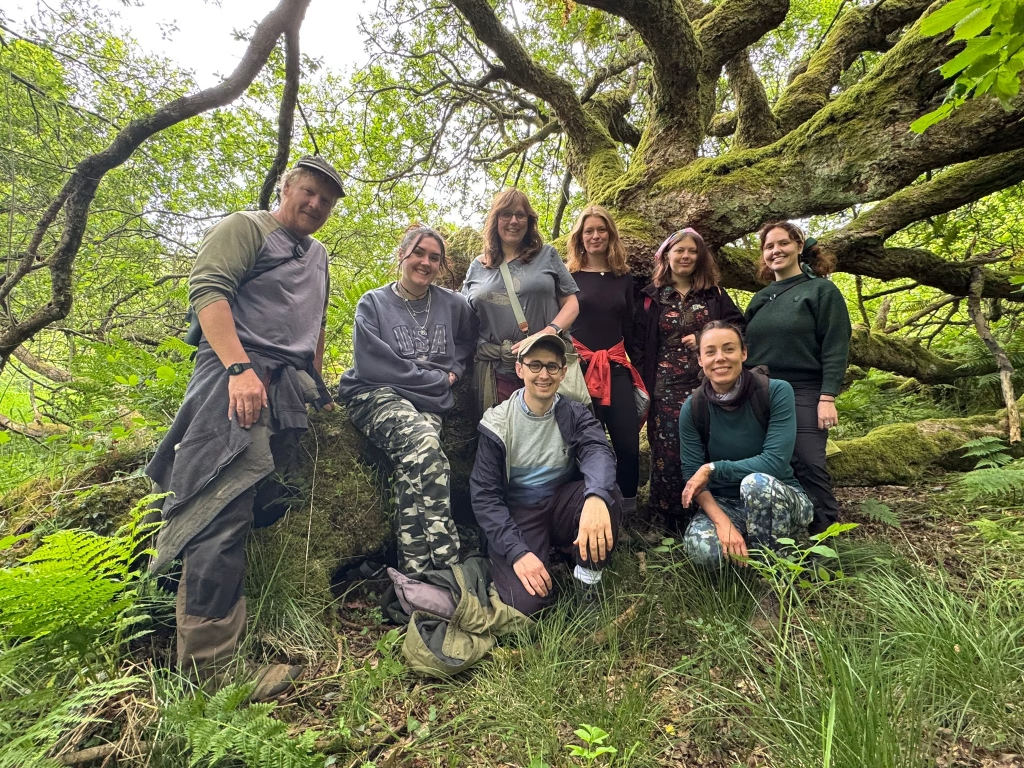The Wild Cardigan Moor Barton Meet Up

A couple of times a year, to ensure that we are more to one another than disembodied heads behind a zoom screen, the Wild Cardigans physically zoom in from across the UK for a real life meet up. Whilst this provides opportunity for us to get into substantial discussions and to plan ahead for the future, it also gives us the chance to get out into nature together and remind ourselves of what the Wild Card project is really all about.
Our Autumn meet up had taken us to the vast landscapes of Scotland and the incredibly exciting project at the Tarras Valley Nature Reserve, a community owned initiative in Langholm which had once been a privately owned grouse moor. This time, we headed to North East Dartmoor and to Moor Barton, a rewilding project on a totally different scale and model.
At 120 acres rather than 10500, you could fit more than 87 Moor Barton’s into the Langholm estate, yet it is no less impressive. With its small mosaic of habitats providing home to many an invertebrate, amphibian, bird and mammal, it is almost impossible to imagine that, less than a generation ago, this place was a conifer plantation. Yet, as we weaved through areas buzzing with life, the stumps of the old industry lingered to remind us of the impact that humans can have on the landscape.
The impact of Robin, our guide, as well as the other humans working and volunteering at Moor Barton, shines with hope for the future: If so much can be achieved for nature in 120 acres, how much more could be achieved were the UK’s largest landowners to follow Moor Barton’s example?
It is no accident that humans are so involved in the project at Moor Barton. Before there was rewilding there, this was a place where people would visit to spend time in the outdoors and nurture nature connection. To exclude humans with an aim to provide a wilderness devoted to other species, would seem at odds with the idea of connectivity. Key to the project is therefore the opportunity for people to learn about the natural world and to get involved in ecological restoration through a calendar of volunteer days, camps and courses.
Humans are identified as a keystone species within this environment. In some spaces, people act as a proxy for other keystone species which are missing from the landscape. No one type of species or species mix can take over dominance under this model and biodiversity can therefore flourish in a range of different habitat types. Humans also work to nurture and protect the other species with whom they share a space, developing a sensitivity to and understanding of them, whatever their role within the ecosystem.
The success of this initiative is evident in the soundscape. Nearby to where the goshawk safely roosts, the air is full of birdsong: The presence of the birds of prey keep away the corvids whilst the songbirds feed on the myriad of native plants and invertebrates which are thriving on the site.
As you emerge from coppiced woodland, you may come across a mixture of scrub and wildflowers alive with insects thanks to the volunteer bracken bashing and the turning of the soil which historically would have been done by wild boar. Or you may arrive at newly made ponds with dragonflies and damselflies darting in a place where once there was nothing but a dark space and a floor of pine needles. With each twist and turn there was more to experience as Robin shared with us, not only his knowledge of the site but also his love for the creatures that he shares it with.
When asked what we enjoyed the most about our visit, there could not be one answer. In this mosaic there were too many favourite spaces to be able to identify just the one. In addition to everything already mentioned, there was the ancient tree that had survived the plantation period (pictured above with Robin and our team) and the thriving wetland created by beavers brought into the site from Scotland. Although it was not the right time of day to spot the beavers themselves, there was joy to be found in observing all that they had created where previously there had just been the trickle of a tiny stream (see image below). It was also inspiring to find out about how this new wetland was supporting so many other species.

What we were observing at Moor Barton was not a wilderness but a harmony. Whilst humans take something from the land, both spiritually and physically, they are mindful to give back to nature too – creating a perfect balance.
Our visit formed an ideal backdrop to the discussions on models of rewilding and ideas of fairness that took place later on during our meet up. There have been a number of injustices that those in the rewilding space need to be aware of. This has included fortress conservation, within which native people have been driven off the land they shared with nature to create a manufactured wilderness. Today, similar injustices are being enacted where people are uprooted from their land either for ecotourism or in the name of carbon and biodiversity offsets. At Wild Card we maintain that the rewilding that nature so desperately needs, given the crisis we are in, must be fairly transitioned to and must involve humans in the process. We have been lucky to see two ideas of this both at Tarras Valley and at Moor Barton.
Moor Barton, in bringing people to the land rather than driving them from it, provides an important model of restoration. Here they don’t just restore ecosystems but also humans’ relationship with the natural world. This duality of restoration is vital to the future well-being and survival of both humans and the more than human.
Our blog posts are written by our core team and guest bloggers. If you have an idea for a blog post please pitch it to us: info@wildcard.land
CAMPAIGNS
ARCHIVES
- December 2025
- November 2025
- October 2025
- September 2025
- August 2025
- July 2025
- June 2025
- May 2025
- April 2025
- March 2025
- February 2025
- December 2024
- November 2024
- October 2024
- September 2024
- August 2024
- July 2024
- June 2024
- March 2024
- February 2024
- January 2024
- December 2023
- November 2023
- August 2023
- July 2023
- May 2023
- February 2023
- January 2023
